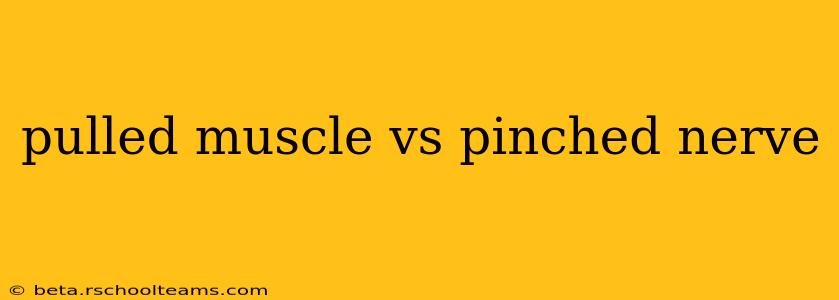Experiencing pain in your back, neck, or limbs can be incredibly debilitating. Two common culprits are pulled muscles and pinched nerves. While both can cause significant discomfort, they have distinct causes, symptoms, and treatments. Understanding the differences is crucial for effective self-care and seeking appropriate medical attention. This guide will help you differentiate between a pulled muscle and a pinched nerve, offering insights into their symptoms, causes, and treatment options.
What is a Pulled Muscle?
A pulled muscle, also known as a muscle strain, occurs when muscle fibers are overstretched or torn. This often happens during sudden movements, strenuous activity, or repetitive motions. The severity of a pulled muscle can range from mild discomfort to a significant tear requiring medical intervention. Common locations for pulled muscles include the back, hamstring, and calf.
Symptoms of a Pulled Muscle:
- Pain: Localized pain at the site of the injury, often worsening with movement or stretching.
- Muscle spasms: Involuntary muscle contractions.
- Swelling: Inflammation around the affected muscle.
- Bruising: In more severe cases.
- Limited range of motion: Difficulty moving the affected area.
- Tenderness to the touch: Pain when pressure is applied to the muscle.
What is a Pinched Nerve?
A pinched nerve, also called a compressed nerve, happens when surrounding tissues, such as bones, cartilage, tendons, or muscles, put pressure on a nerve. This pressure can interfere with the nerve's ability to send signals, leading to pain, numbness, tingling, or weakness. Pinched nerves can occur anywhere in the body but are common in the neck (cervical radiculopathy) and lower back (lumbar radiculopathy).
Symptoms of a Pinched Nerve:
- Pain: Radiating pain along the nerve's pathway, often described as sharp, shooting, or burning.
- Numbness: Loss of sensation in the affected area.
- Tingling: Pins and needles sensation.
- Weakness: Difficulty moving or controlling muscles supplied by the pinched nerve.
- Muscle atrophy: In severe or long-lasting cases.
Pulled Muscle vs. Pinched Nerve: Key Differences
| Feature | Pulled Muscle | Pinched Nerve |
|---|---|---|
| Cause | Overstretched or torn muscle fibers | Compression of a nerve by surrounding tissues |
| Pain Location | Localized to the injured muscle | Radiating along the nerve's pathway |
| Pain Type | Aching, soreness, cramping | Sharp, shooting, burning, electric shock-like |
| Other Symptoms | Swelling, bruising, muscle spasms | Numbness, tingling, weakness, muscle atrophy |
How to Tell if it's a Pulled Muscle or a Pinched Nerve?
Differentiating between a pulled muscle and a pinched nerve can be challenging, as some symptoms overlap. However, the location and type of pain are key differentiators. A pulled muscle typically causes localized pain directly in the injured muscle, while a pinched nerve produces pain that radiates along the nerve's pathway. The presence of numbness, tingling, or weakness strongly suggests a pinched nerve.
What Causes Pulled Muscles?
- Sudden movements: Jerking, twisting, or lifting heavy objects improperly.
- Overexertion: Pushing your muscles beyond their limits during exercise or physical activity.
- Repetitive strain: Performing the same motion repeatedly, leading to micro-tears in the muscle.
- Poor posture: Maintaining poor posture can strain muscles over time.
- Lack of warm-up: Starting strenuous activities without proper warm-up increases the risk of muscle strains.
What Causes Pinched Nerves?
- Poor posture: Sustained poor posture can compress nerves.
- Spinal stenosis: Narrowing of the spinal canal.
- Herniated disc: A bulging or ruptured intervertebral disc can press on nerves.
- Osteoarthritis: Degeneration of the joints can lead to nerve compression.
- Spondylolisthesis: Forward slippage of one vertebra over another.
- Injury: Trauma from accidents or falls can cause nerve compression.
- Repetitive movements: Certain repetitive movements can irritate and compress nerves over time.
How are Pulled Muscles and Pinched Nerves Treated?
Treatment for both pulled muscles and pinched nerves often involves a combination of conservative measures:
- Rest: Avoiding activities that aggravate the pain.
- Ice: Applying ice packs to reduce swelling and inflammation.
- Compression: Using a bandage to provide support and reduce swelling.
- Elevation: Raising the affected limb to reduce swelling.
- Over-the-counter pain relievers: Such as ibuprofen or acetaminophen.
- Physical therapy: To improve strength, flexibility, and range of motion.
In cases of severe pain or persistent symptoms, medical intervention may be necessary. This could include:
- Corticosteroid injections: To reduce inflammation around the nerve.
- Surgery: In severe cases of pinched nerves or herniated discs that don't respond to conservative treatment.
Disclaimer: This information is for general knowledge and does not constitute medical advice. Always consult a healthcare professional for diagnosis and treatment of any medical condition. Self-treating can be dangerous, and professional guidance is essential for optimal recovery.
